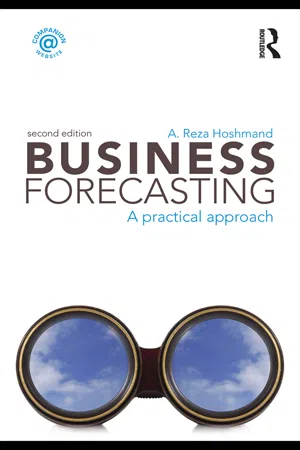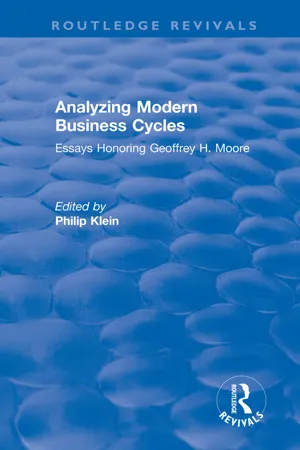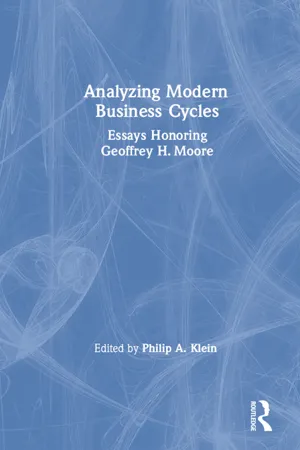Economic Cycle
The economic cycle refers to the natural fluctuation of economic activity between periods of expansion and contraction. It is characterized by alternating phases of growth, peak, recession, and trough. These cycles are influenced by various factors such as consumer spending, business investment, and government policies, and they have a significant impact on employment, inflation, and overall economic health.
8 Key excerpts on "Economic Cycle"
- eBook - ePub
Business Forecasting
A Practical Approach
- A. Reza Hoshmand(Author)
- 2009(Publication Date)
- Routledge(Publisher)
...3 The Macroeconomy and Business Forecasts Nations seek economic growth, full employment, and price-level stability as their major macroeconomic goals. Business decisions are made in the context of the macroeconomy of a nation. Firms take their cues from the economic environment in which they operate. When favorable macroeconomic conditions prevail, businesses expand operation and output. Contractions in the economy generally lead to slower growth patterns. Long-run economic growth has not always been steady as factors such as inflation, unemployment, recession, and depression have impacted it negatively. As was pointed out in Chapter 2, long-term trends, seasonal variations, cyclical movements, and irregular factors combine to generate widely divergent paths for businesses in an economy. Given these conditions, how are businesses to predict future growth and contractions in the economy? In this chapter we will discuss specifically those cyclical linkages that bind the economy together during a typical business cycle, and how our knowledge of these linkages help us in making good forecasts at the industry and firm level. 3.1 Phases of the Business Cycle Economists use the term “business cycle” when they observe alternating increases and decreases in the level of economic activity, sometimes extending over several years. The duration and intensity of the cycle vary from cycle to cycle. Yet all business cycles display common phases, which are variously labeled by economists. A business cycle generally follows the four phases of peak, recession, trough, and recovery. Peak refers to the economic condition at which business activity has reached a temporary maximum and shows the onset of a recession or upper turning point. During this phase the economy is at full employment and the level of real output is at, or very close to, its capacity. It is expected that the price level will rise during this phase of the business cycle. Recession follows a peak in the economy...
- eBook - ePub
Economics for Investment Decision Makers
Micro, Macro, and International Economics
- Christopher D. Piros, Jerald E. Pinto(Authors)
- 2013(Publication Date)
- Wiley(Publisher)
...However, other factors, such as money and inflation, are more specific to short-term fluctuations. This chapter is organized as follows. Section 2 describes the business cycle and its phases, explaining the behaviors of businesses and households that typically characterize phases and transitions between phases. Section 3 provides an introduction to business cycle theory, in particular how different economic schools of thought interpret the business cycle and their recommendations with respect to it. Section 4 introduces basic concepts concerning unemployment and inflation, two important economic policy concerns that are sensitive to the business cycle. Section 5 discusses variables that fluctuate in predictable time relationships with the economy, focusing on variables whose movements have value in predicting the future course of the economy. A summary and practice problems conclude the chapter. 2. OVERVIEW OF THE BUSINESS CYCLE Burns and Mitchell (1946) define the business cycle as follows: Business cycles are a type of fluctuation found in the aggregate economic activity of nations that organize their work mainly in business enterprises: a cycle consists of expansions occurring at about the same time in many economic activities, followed by similarly general recessions, contractions, and revivals which merge into the expansion phase of the next cycle; this sequence of events is recurrent but not periodic; in duration, business cycles vary from more than one year to 10 or 12 years. This long definition is rich with important insights. First, business cycles are typical of economies that rely mainly on business enterprises—therefore, not agrarian societies or centrally planned economies. Second, a cycle has an expected sequence of phases representing alternation between expansion and contraction. Third, such phases occur at about the same time throughout the economy—that is, not just in agriculture or not just in tourism but in almost all sectors...
- eBook - ePub
Contemporary Economics
An Applications Approach
- Robert Carbaugh(Author)
- 2016(Publication Date)
- Routledge(Publisher)
...Then national output declines, profits and real incomes decrease, and the unemployment rate increases to uncomfortably high levels as many workers lose their jobs. Eventually, the economic contraction vanishes and recovery begins. The recovery may be slow or fast. It may be partial, or it may be so strong that it results in a new era of prosperity. Or it may be characterized by escalating inflation, soon to be followed by another downturn. The upward and downward movements in output, employment, and inflation form the business cycle that characterizes all market economies. Phases of the Business Cycle The term business cycle refers to recurrent ups and downs in the level of economic activity over several years. Although business cycles may vary in intensity and duration, we can divide each into four phases, as shown in Figure 11.2. Peak. At the peak of a business cycle, real GDP is at its highest point. Employment and profits are usually strong. Recession. A recession is a period of significant decline in total output, income, employment, and trade, that usually lasts from 6 months to a year and is marked by widespread contraction in many sectors in the economy. A recession begins at a peak and ends at a trough. For example, the U.S. economy began the Great Recession in December 2007, which lasted until June 2009. A typical recession boosts the unemployment rate up more than three percentage points. Even small recessions increase the unemployment rate more than two points. Trough. The low point of real GDP, just before it begins to turn upward, is called the trough of a business cycle. At the trough, unemployment and idle productive capacity are at their highest levels relative to the previous recession. The trough may be short-lived or quite long. Recovery. Recovery is an upturn in the business cycle during which real GDP rises...
- eBook - ePub
Mastering The Market Cycle
Getting the Odds on Your Side
- Howard Marks(Author)
- 2018(Publication Date)
- Harper Business(Publisher)
...IV The Economic Cycle The output of an economy is the product of hours worked and output per hour; thus the long-term growth of an economy is determined primarily by fundamental factors like birth rate and the rate of gain in productivity (but also by other changes in society and environment). These factors usually change relatively little from year to year, and only gradually from decade to decade. Thus the average rate of growth is rather steady over long periods of time. Given the relative stability of underlying secular growth, one might be tempted to expect that the performance of economies would be consistent from year to year. However, a number of factors are subject to variability, causing economic growth—even as it follows the underlying trendline on average—to also exhibit annual variability. The Economic Cycle (also known—mostly in the past—as “the business cycle”) provides much of the foundation for cyclical events in the business world and the markets. The more the economy rises, the more likely it is that companies will expand their profits and stock markets will rise. I’ll touch briefly here on the factors that influence Economic Cycles. But before I do so, I want to make the confession I volunteer whenever I discuss economics (or is it a proud proclamation?): I’m no economist. I took courses in economics as both an undergraduate and a graduate student. I think about economics. I deal with economics as a professional investor. And I consider myself to be largely an “economic man” who makes most decisions for logical reasons based on the relationship between cost and value, risk and potential return. But my thinking about economics is based largely on common sense and experience, and I’m sure I’ll write things here with which many economists will disagree. (Of course, they also disagree with each other...
- Li Jianwei(Author)
- 2017(Publication Date)
- Routledge(Publisher)
...5 Categories of Economic Cycles and analysis of the factors affecting their periods Traditional Western business cycle theories divide business cycles into short cycle, mid cycle, mid-to-long cycles and long cycles according to the period of the business cycle. The business cycles can also be classified into agricultural cycle, inventory cycle, equipment investment cycle, construction cycle and technological cycle, according to the determining factors of the business cycles. In reality, the periodic changes of economic indicators are often irregular. The duration and magnitude of the fluctuation of a single economic indicator can be very different in different time periods, making it difficult for traditional business cycle theories to explain. The analysis in this chapter shows that the growth of consumer demand and the economy as a whole embodies a type of endogenous cycle, namely the income distribution cycle, which is determined by the normality of household income distribution. The basic factors determining the period of the income distribution cycle are household income and consumer price level. Greater household income, higher household income growth rate, less income inequality, lower consumer price level and larger decline in price will shorten the period of the income distribution cycle. In addition, there are also actual demand cycles. Supply lag, replacement demand, product innovation and export can also give rise to the price adjustment cycle, replacement demand cycle, innovation demand cycle, export cycle and other actual demand cycles. The periods of these cycles depend on the length of supply lag period, the service lives of durable consumer goods, the frequency of product innovation, the distribution of foreign household income, export competitiveness and other factors. Through its impacts on household income and consumer price level, actual demand cycles affect the period of the income distribution cycle...
- eBook - ePub
Analyzing Modern Business Cycles
Essays Honoring
- Philip Klein(Author)
- 2017(Publication Date)
- Routledge(Publisher)
...First, for theoretical and policy purposes, it is necessary to treat each business cycle as an individual. It is important to do so since each cycle varies from one to the next in respect to amplitude and duration; and each varies in the timing and nature of the changes of the co-movements of key variables, which contribute to the variations in ampli tude and duration. Nevertheless, one is justified in studying business cycles as a group since "each cycle in some important ways in its decomposition into sectors and in the aggregate bears a close 'family likeness' to earlier cycles" (Boehm and Moore 1984, 35; see also Hicks 1950, 2). Secondly, interrelated with the first point, there are considerable but varying degrees of endogeneity from one business cycle to another as well as exogenous elements. Hence, business cycles cannot be explained entirely as the result of random events or unanticipated monetary shocks, as suggested by rational expectation theorists (Lucas and Sargent 1979, 14), or of random real shocks to technology as invoked by real business cycle exponents (Kydland and Prescott 1982; Long and Plosser 1983). The concept of the price-cost cycle is briefly reviewed. This recognizes an additional, largely endogenous force which helps to fill an important gap in business cycle theory concerning why the main business cycle in industrialized democracies is of relatively short duration. Thirdly, in formulating an adequate and acceptable theory, more explicit attention needs to be paid to the empirical evidence on business cycles. On the other hand, some empirical evidence itself, or at least the way it has been interpreted, may have contributed to a misunderstanding of the true characteristics of business cycles. This applies to both earlier theorists and the recent rational expectations and real business cycle theorists...
- eBook - ePub
Analysing Modern Business Cycles
Essays Honoring Geoffrey H.Moore
- Philip A. Klein(Author)
- 2019(Publication Date)
- Routledge(Publisher)
...First, for theoretical and policy purposes, it is necessary to treat each business cycle as an individual. It is important to do so since each cycle varies from one to the next in respect to amplitude and duration; and each varies in the timing and nature of the changes of the co-movements of key variables, which contribute to the variations in amplitude and duration. Nevertheless, one is justified in studying business cycles as a group since “each cycle in some important ways in its decomposition into sectors and in the aggregate bears a close ‘family likeness’ to earlier cycles” (Boehm and Moore 1984, 35; see also Hicks 1950, 2). Secondly, interrelated with the first point, there are considerable but varying degrees of endogeneity from one business cycle to another as well as exogenous elements. Hence, business cycles cannot be explained entirely as the result of random events or unanticipated monetary shocks, as suggested by rational expectation theorists (Lucas and Sargent 1979, 14), or of random real shocks to technology as invoked by real business cycle exponents (Kydland and Prescott 1982; Long and Plosser 1983). The concept of the price-cost cycle is briefly reviewed. This recognizes an additional, largely endogenous force which helps to fill an important gap in business cycle theory concerning why the main business cycle in industrialized democracies is of relatively short duration. Thirdly, in formulating an adequate and acceptable theory, more explicit attention needs to be paid to the empirical evidence on business cycles. On the other hand, some empirical evidence itself, or at least the way it has been interpreted, may have contributed to a misunderstanding of the true characteristics of business cycles. This applies to both earlier theorists and the recent rational expectations and real business cycle theorists...
- eBook - ePub
Essays
On Entrepreneurs, Innovations, Business Cycles and the Evolution of Capitalism
- Joseph A. Schumpeter(Author)
- 2017(Publication Date)
- Routledge(Publisher)
...We may, then, speak either of an equilibrium of growth or — as we prefer — of an equilibrium which, though continually disturbed by growth, continually tends to be re-established. There is nothing in this which, by itself, could produce the business cycle. Professor Pigou lends the weight of his authority to this proposition, by word as well as tacendo. And indeed theories looking for an explanation of the cycle in the increase either of population or of capital seem to me hardly worth discussing. (3) I always thought, and still think, that in order to find out whether or not cycles are a phenomenon sui generis, clearly standing out as such from the rest of industrial fluctuations and arising from within the economic system, we ought, in the first instance, to assume the absence of outside disturbances — non-economic ones, or economic ones which cannot be produced or avoided by economic action, both of which we are going to call “casual” — acting on the system...







